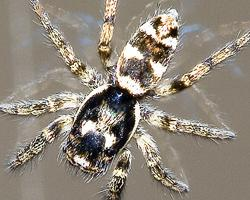
Váhy a míry
| Délka | od 5 do 7 mm |
|---|
Stav ohrožení
| Neohrožen |
Popis zvířete
The Zebra spider, scientifically known as Salticus scenicus, is a species of jumping spider that captivates the interest of both arachnologists and enthusiasts alike due to its distinctive appearance and fascinating behavior. This small but remarkable spider is commonly found across the Holarctic region, making its home in a variety of environments that range from European gardens to North American backyards.One of the most striking features of the Zebra spider is its unique coloration and pattern, from which its common name is derived. The spider's body is predominantly black, adorned with white stripes or bands that run across its cephalothorax and abdomen, giving it a zebra-like appearance. This distinctive patterning not only serves as camouflage among the rocks, leaves, and debris where it hunts but also plays a role in its mating rituals.
Adult Zebra spiders are relatively small, with females reaching lengths of up to 7 millimeters, while males are slightly smaller, typically measuring around 5 millimeters. Despite their diminutive size, these spiders are known for their remarkable jumping ability, which they utilize both to ambush prey and to escape predators. They can leap distances multiple times their body length, a feat made possible by their well-developed hind legs and a unique internal hydraulic system that allows them to change the pressure of fluid within their bodies, propelling them into the air.
The Zebra spider is a diurnal hunter, relying heavily on its exceptional vision to spot potential prey. It possesses four pairs of large, forward-facing eyes that give it almost 360-degree vision, enabling it to accurately judge distances and plan its attack with precision. This visual acuity is crucial, as the spider does not spin webs to catch food. Instead, it employs a stalk-and-pounce technique, creeping up on unsuspecting insects before leaping onto them. Once captured, the prey is subdued with a venomous bite.
Reproduction in Zebra spiders involves a complex and intriguing courtship ritual, where the male performs a series of dances and vibratory signals to attract a female. If successful, mating ensues, leading to the female laying eggs in a silk sac, which she fiercely guards until the spiderlings emerge.
The Zebra spider's lifecycle and behaviors make it a fascinating subject of study. Its adaptability to various habitats, including human dwellings, and its role in controlling insect populations underscore its importance in the ecosystem. Despite its small size, the Zebra spider is a remarkable example of the complexity and beauty that can be found in the natural world, embodying the intricate balance of form, function, and behavior that characterizes the arachnid family.
Nové fotografie zvířat
Top 10 zvířat
- Chinese water dragon (Physignathus cocincinus)
- Galápagos tortoise (Geochelone nigra complex)
- Dolphin gull (Leucophaeus scoresbii)
- Japanese macaque (Macaca fuscata)
- Colombian red howler (Alouatta seniculus)
- Sea urchins (Echinoidea)
- Diana monkey (Cercopithecus diana)
- Moustached guenon (Cercopithecus cephus)
- Colossal squid (Mesonychoteuthis hamiltoni)
- Common reed warbler (Acrocephalus scirpaceus)